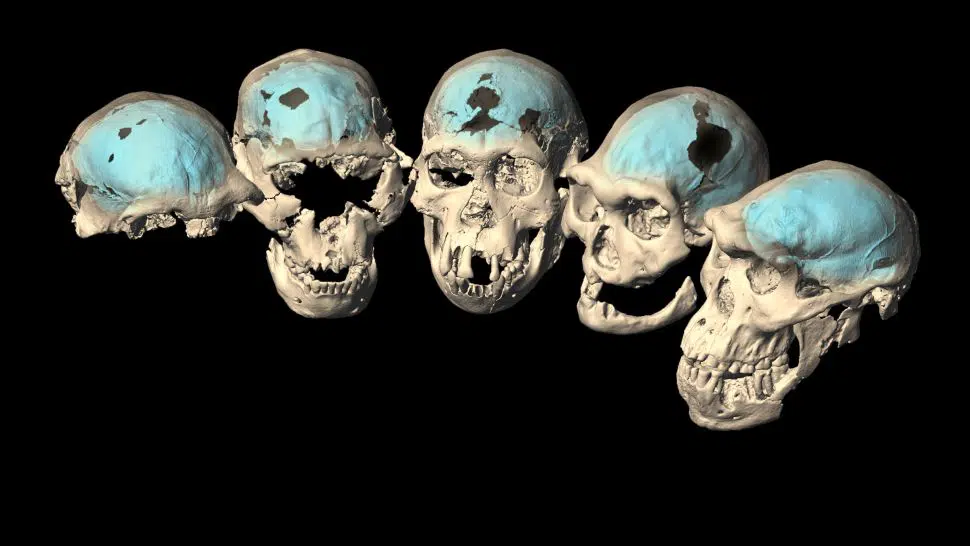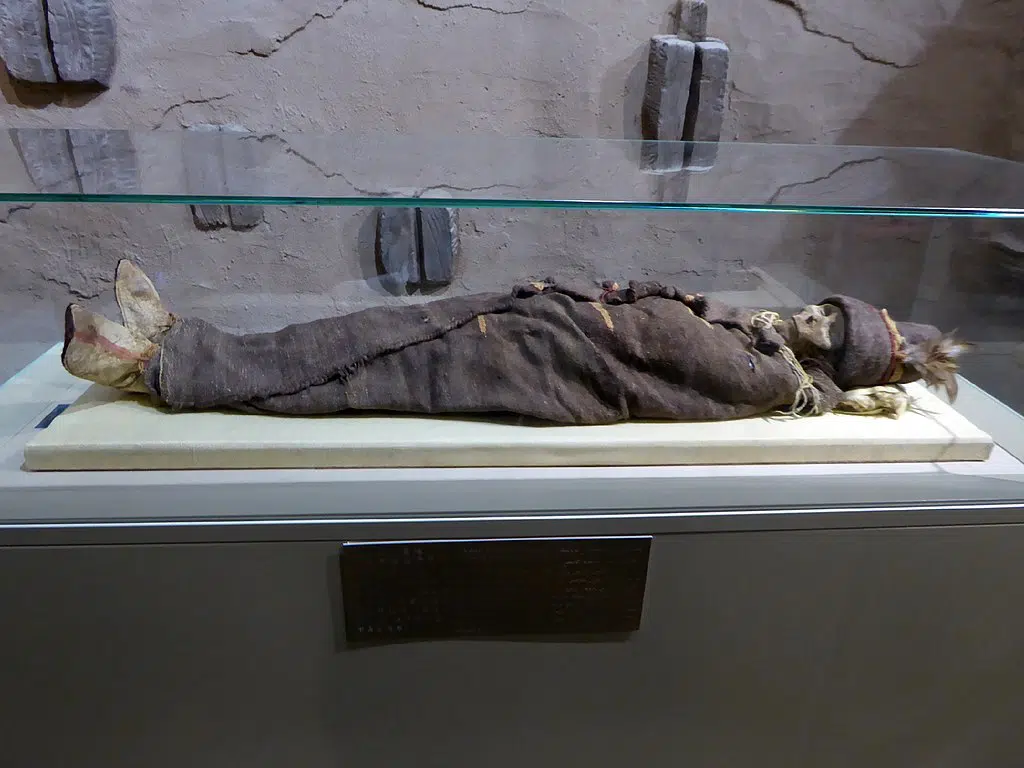
The ten most fascinating things discovered about our human ancestors were not difficult to decide this past year, which was a banner year in the field of research into human history.
From North America through Europe and Asia, scientists who study ancient origins were treated to a wealth of new discoveries which shed great light into humanity’s distant past.
So here, in chronological order, are the discoveries made about our human ancestors that are among the most amazing of 2021:
1. It took one million years for ape-like brains to develop into human brains
The five well-preserved Homo erectus skulls found in Dmanisi, Georgia, dating back to between 1.85 million and 1.77 million years ago, show that it took approximately one million years for ape-like brains to develop into our Homo sapiens-size brains, according to a study published in the journal Science.
2. “Dragon man” skull research results in naming of new species
An ancient human skull that was found in China in the 1930’s but researched anew last year led to the naming of a brand new species: Homo longi, or “Dragon man.” The studies detailing the new research were published in the journal The Innovation.
The Dragon Man skull, dated back to 130,000 years ago, is the largest Homo skull ever found. The man, who had been 50 years old at the time of his death, lived on the earth at the same time as Homo sapiens, but some archaeologists think we may have a common ancestor as far back as 950,000 years ago.
Most researchers believe Dragon Man was closer to Denisovans (see two stories below) who had more in common with Neanderthals than they do Homo sapiens.
3. The naming of Homo bodoensis
As described in the Journal Evolutionary Anthropology: Issues, News, and Reviews in October, a 600,000- year-old skull found in 1976 in Africa belonged to a member of yet another new species, Homo bodoensis. Thriving there in the Middle Pleistocene era, he may be an ancestor of Homo sapiens.
The naming of the new species occurred after a wide-ranging look back ino individuals who were previously grouped as H. heidelbergensis and H. rhodesiensis. Now, some H. heidelbergensis specimens could be viewed as Neanderthals or H. bodoensis.
4. 200,000-year-old footprints left in sand were mankind’s first “parietal” artwork
Eerie reminders of our distant human past were discovered this past year in yet another of some of the strangest archaeological finds of 2021. And again they come to us courtesy of the Denisovans, the Asiatic people who one elived in Siberia’s Denisova Cave.
Sets of 200,000-year-old handprints and footprints that had been left by children in a cave in what is now Tibet spoke to us over the millennia, binding us to our distant history.
Noting that the prints had been “carefully placed,” archaeologist Sally Reynolds, a specialist in hominid paleoecology, argues that this is the very first piece of art ever to have been deliberately produced by human beings.
Created during the Pleistocene era, Reynolds says they are “the only examples (of art from) an extinct group known as the Denisovans, who coexisted with the Neanderthals in Europe… it’s a beautiful panel with hand and footprints which have been carefully placed so they fill a certain space. We argue that this fulfills the definition of “parietal art” (for example, art made in the caves of western Europe and elsewhere).
5. 150,000 year-old beads — oldest made by humans — discovered in Morocco
Although perhaps appearing as a mere trifle and an anthropological aside, the existence of 150,000-year-old beads, in Morocco, points to a certain level of human development in which people had enough food and necessary shelter that they could devote themselves to the making of such labor-intensive articles as beads.
Whether for ornament or for showing membership in a certain tribe or clan, the beads were made with great care and their manufacture took a great deal of time.
Anthropologist Steven Kuhn stated to reporters when they were displayed before the public for the first time “It’s widely thought that this kind of ornamentation marks a period when humans’ social worlds were beginning to expand.
“People were traveling farther, meeting other kinds of people that they might not have known, might not have been familiar with, and it was worth their time to signal from a distance ‘I’m from the tribe over there’ or ‘I’m a married person so you need to treat me in particular way.’ It indicates an expansion of social worlds.”
6. China’s Bronze Age Tarim mummies may be ancestors of North American natives

DNA studies on Bronze Age Tarim mummies found in China’s western Xinjiang region revealed recently that not only were these people not descendants of Indo-Europeans who had immigrated to the area — they may in fact be the ancestors of Native Americans.
With genes that are shared between them, people living in Siberia, and Native Americans, the “Tarim mummies” have now been proven to be clearly related to these groups, according to a study that was published on Oct. 27 in the journal Nature.
While scientists originally thought that they may have come overland from the West, the DNA sequencing showed that they actually had origins near where they were found, in the deserts of western China.
7. Recreation of Neanderthal face includes tumor humans suffer from today

The artistic recreation of a grinning Neanderthal face took the internet by storm last year; the man not only showed the great good humor that many of our ancestors must have had – it also shows that they suffered from the same kind of tumor that we do today.
A recreation of a Neanderthal man’s face is turning heads all over the world – not only for its strong resemblance to our own physiognomy today but also because of the good humor it exudes, as much as 70,000 years after the man died.
Believed to have lived in Doggerland, which was once dry land but now forms the seabed in the North Sea between the United Kingdom and continental Europe, he died between 50,000 and 70,000 years ago, according to the researchers.
Interestingly, the man also suffered from a small intradiploic epidermoid cyst above one eyebrow. Located in the skin layers, tumors like these are normally slow-growing and benign. The artists decided to recreate the man, tumor and all, to show that ancient mankind suffered from many of the same maladies that we do today.
8. Oldest-known Denisovan fossils found
The Bashalaksky Range of the Altai Mountains in Siberia is the site of the Cave of the Denisovans, the mysterious peoples who scientists believe originated in that very area. As ancestors of all Asiatic peoples — including all Native Americans — the identification of the Denisovans as a distinct people several years ago was groundbreaking.
In 2021, scientists uncovered the remains of the oldest-known Denisovan individuals, who lived approximately 200,000 years ago, as reported in Live Science.
Researchers now have fossils from an additional three Denisovan individuals from the eponymous cave in which they were first discovered.
9. Stunning bracelets made by Denisovans 45,000 years ago
Traces of both Neanderthals and Denisovans have also been found there, showing that they inhabited it between 40,000 and 30,000 years ago. The study showing the habitation of the two peoples in the cave was published in the Journal of the Proceedings of the National Academy of Sciences.
Paleolithic jewelry created at least 45,000 years ago, which was found in the southern gallery of Denisova Cave — including a stone bracelet made of white marble — comes after the discovery of an earlier bracelet, made of Chloritolite. That stunningly beautiful, jade-green bracelet is thought to have been worn for ceremonial purposes.
Found in 2008, it was one of the first objects found in the eastern end of the Denisova Cave, showing fine technical skills that scientists had thought were developed much later.
10. Oldest fossilized footprints found in the Americas
White Sands National Park in New Mexico was the site of another groundbreaking discovery in human history in 2021 when researchers found 60 fossilized human footprints.
Of course, the date when peoples first emigrated to the Americas is still up for debate. In the past, some researchers held that it took place during the last glacial period, approximately 13,000 years ago.
However, that date was thrown out of the window this past year after the discovery of the footprints, which had been made in an ancient lake bed between 23,000 and 21,000 years before the present.
Many researchers had dated the settlement of the Americas back to 13,000 years ago, when the first Clovis points were created, as indicated in the nearby area of Clovis, New Mexico. Similar points were subsequently identified all over North America.
The footprints found last year constitute the first definitive proof that people lived here during the Last Glacial Maximum, which lasted from 26,500 to 19,000 years ago. The study on the origin and dating of the footprints was published in the journal Science.
See all the latest news from Greece and the world at Greekreporter.com. Contact our newsroom to report an update or send your story, photos and videos. Follow GR on Google News and subscribe here to our daily email!



